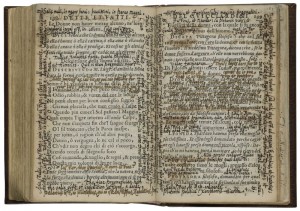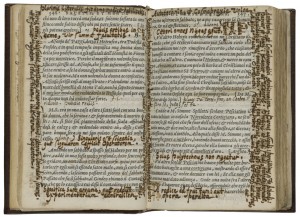Marginalia > space
For as assiduous an annotator as Gabriel Harvey, few things would have been as annoying as running out of white space. Indeed, he often used every inch of white space available, as this image shows:

It also becomes clear that, even with sufficient space, Harvey still needed to take the layout of the printed text into account, as a result of which his marginal notes snake around and sometimes through it.
The challenges posed by the layout of the text and the size of the page made it necessary for Harvey, who could be fairly long-winded, to link parts of his extensive marginal notes to each other. Often he employed marks or symbols to establish such a link, while he also repeated the first word of the subsequent part of the marginal annotation, thereby imitating a manuscript convention that had also found its way to printed books. By including such signifiers, Harvey provided his readers with a guide as to how his marginal notes should be read.

As this image shows, Harvey enthusiastically started writing in the right margin of the page (f. 14r), but once he had written the word “aut” he found himself out of space. Therefore, he wrote an equal sign and continued the marginal note in the printed text, also starting it with an equal sign to signify the link between the two parts. Harvey still hadn’t finished though, and ran out of space again! He repeated the last word of this part of the marginal note, “Extentu,” in the left margin, where he cheerfully carried on writing. Yet the page continued to challenge him, and he found himself without space yet again. The marginal note ends with a column, a signifier that this marginal note still wasn’t finished. Harvey continued writing in the gutter of the preceding page (f. 13v), showing that he considered the whole opining, not just a side of a folio, as the page.
Now things are starting to get interesting from the point of view of our schema as well, as we’ve decided that the transcriptions capture all the reader’s interventions on a single page but we now come face-to-face with a marginal note that deftly defies the structure of our schema. This poses a challenge we need to solve, for it happens more than once. In another blog post, which is due to appear in the near future, I’ll discuss the solution we came up with.
